Tourism and Hospitality: Trends and Marketing Strategies Analysis
VerifiedAdded on 2023/03/16
|8
|2122
|61
Essay
AI Summary
This essay provides an in-depth analysis of the tourism and hospitality industries, focusing on the trends and developments that occurred during the 20th century. It begins with an introduction to the significance of the travel and tourism sector in the global economy, emphasizing the impact of technological advancements and digital integration. The main body of the essay explores the evolution of the tourism industry, highlighting the influence of transportation, communication, and information technologies. It examines how these changes have transformed the industry, making travel more accessible and shaping marketing strategies to attract a wider audience. The essay also discusses the impact of social and cultural shifts, including rising living standards and changing attitudes towards leisure and travel. Furthermore, it differentiates between mass tourism and niche tourism, analyzing their respective impacts on the industry. The essay concludes by summarizing the key changes observed in the 20th century and their implications for future growth, emphasizing the importance of government support and sustainable practices within the sector.
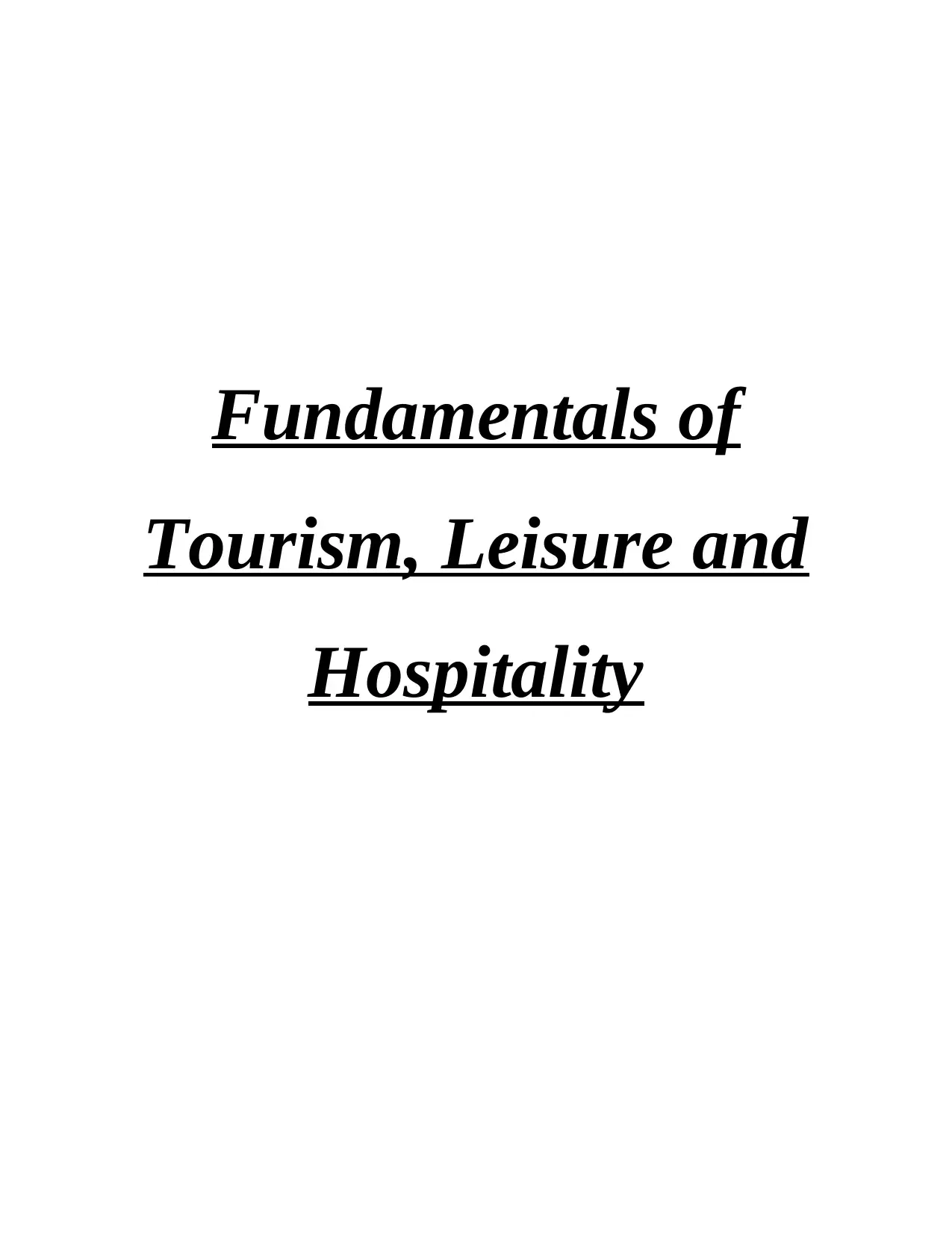
Fundamentals of
Tourism, Leisure and
Hospitality
Tourism, Leisure and
Hospitality
Paraphrase This Document
Need a fresh take? Get an instant paraphrase of this document with our AI Paraphraser
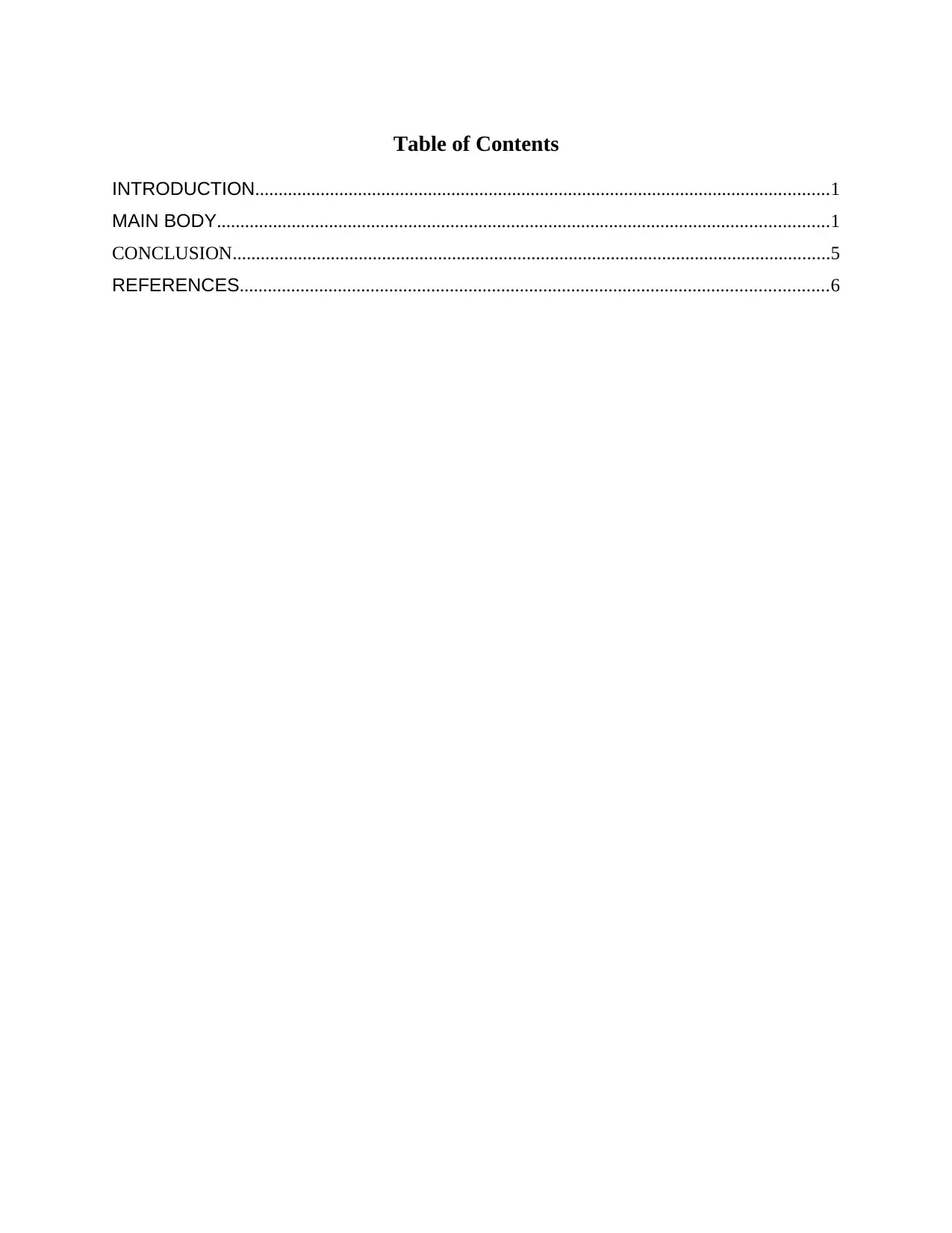
Table of Contents
INTRODUCTION...........................................................................................................................1
MAIN BODY...................................................................................................................................1
CONCLUSION................................................................................................................................5
REFERENCES..............................................................................................................................6
INTRODUCTION...........................................................................................................................1
MAIN BODY...................................................................................................................................1
CONCLUSION................................................................................................................................5
REFERENCES..............................................................................................................................6
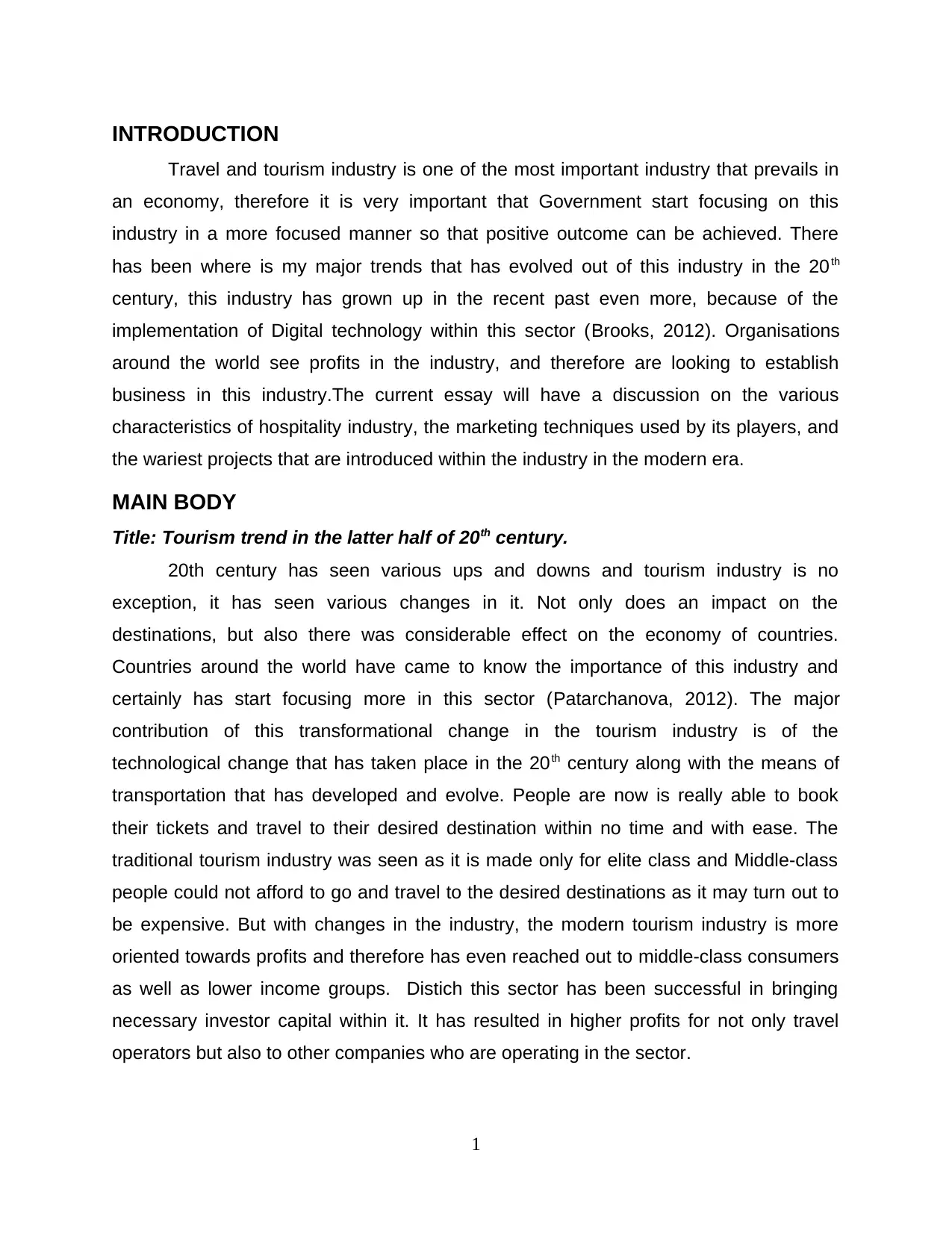
INTRODUCTION
Travel and tourism industry is one of the most important industry that prevails in
an economy, therefore it is very important that Government start focusing on this
industry in a more focused manner so that positive outcome can be achieved. There
has been where is my major trends that has evolved out of this industry in the 20th
century, this industry has grown up in the recent past even more, because of the
implementation of Digital technology within this sector (Brooks, 2012). Organisations
around the world see profits in the industry, and therefore are looking to establish
business in this industry.The current essay will have a discussion on the various
characteristics of hospitality industry, the marketing techniques used by its players, and
the wariest projects that are introduced within the industry in the modern era.
MAIN BODY
Title: Tourism trend in the latter half of 20th century.
20th century has seen various ups and downs and tourism industry is no
exception, it has seen various changes in it. Not only does an impact on the
destinations, but also there was considerable effect on the economy of countries.
Countries around the world have came to know the importance of this industry and
certainly has start focusing more in this sector (Patarchanova, 2012). The major
contribution of this transformational change in the tourism industry is of the
technological change that has taken place in the 20th century along with the means of
transportation that has developed and evolve. People are now is really able to book
their tickets and travel to their desired destination within no time and with ease. The
traditional tourism industry was seen as it is made only for elite class and Middle-class
people could not afford to go and travel to the desired destinations as it may turn out to
be expensive. But with changes in the industry, the modern tourism industry is more
oriented towards profits and therefore has even reached out to middle-class consumers
as well as lower income groups. Distich this sector has been successful in bringing
necessary investor capital within it. It has resulted in higher profits for not only travel
operators but also to other companies who are operating in the sector.
1
Travel and tourism industry is one of the most important industry that prevails in
an economy, therefore it is very important that Government start focusing on this
industry in a more focused manner so that positive outcome can be achieved. There
has been where is my major trends that has evolved out of this industry in the 20th
century, this industry has grown up in the recent past even more, because of the
implementation of Digital technology within this sector (Brooks, 2012). Organisations
around the world see profits in the industry, and therefore are looking to establish
business in this industry.The current essay will have a discussion on the various
characteristics of hospitality industry, the marketing techniques used by its players, and
the wariest projects that are introduced within the industry in the modern era.
MAIN BODY
Title: Tourism trend in the latter half of 20th century.
20th century has seen various ups and downs and tourism industry is no
exception, it has seen various changes in it. Not only does an impact on the
destinations, but also there was considerable effect on the economy of countries.
Countries around the world have came to know the importance of this industry and
certainly has start focusing more in this sector (Patarchanova, 2012). The major
contribution of this transformational change in the tourism industry is of the
technological change that has taken place in the 20th century along with the means of
transportation that has developed and evolve. People are now is really able to book
their tickets and travel to their desired destination within no time and with ease. The
traditional tourism industry was seen as it is made only for elite class and Middle-class
people could not afford to go and travel to the desired destinations as it may turn out to
be expensive. But with changes in the industry, the modern tourism industry is more
oriented towards profits and therefore has even reached out to middle-class consumers
as well as lower income groups. Distich this sector has been successful in bringing
necessary investor capital within it. It has resulted in higher profits for not only travel
operators but also to other companies who are operating in the sector.
1
⊘ This is a preview!⊘
Do you want full access?
Subscribe today to unlock all pages.

Trusted by 1+ million students worldwide
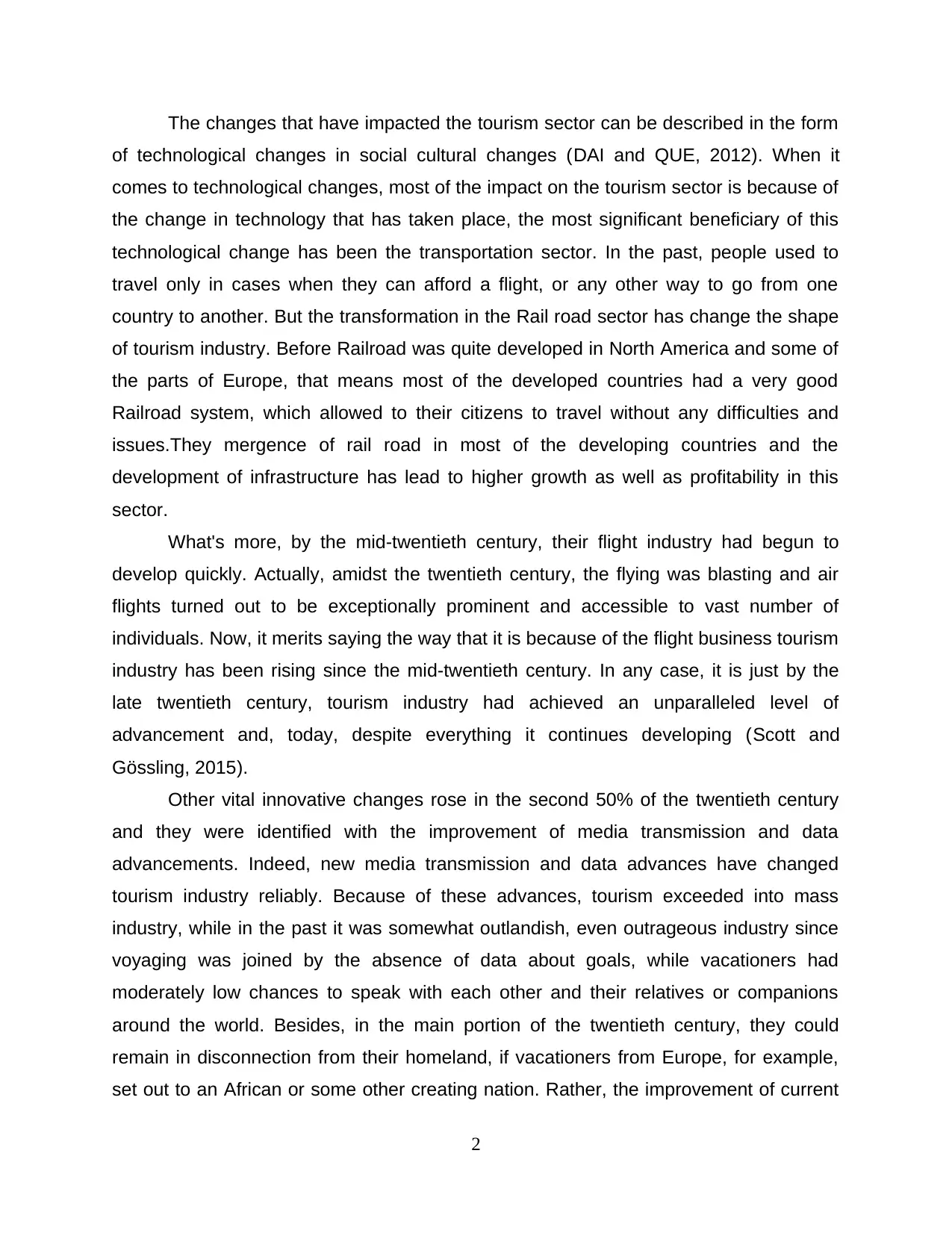
The changes that have impacted the tourism sector can be described in the form
of technological changes in social cultural changes (DAI and QUE, 2012). When it
comes to technological changes, most of the impact on the tourism sector is because of
the change in technology that has taken place, the most significant beneficiary of this
technological change has been the transportation sector. In the past, people used to
travel only in cases when they can afford a flight, or any other way to go from one
country to another. But the transformation in the Rail road sector has change the shape
of tourism industry. Before Railroad was quite developed in North America and some of
the parts of Europe, that means most of the developed countries had a very good
Railroad system, which allowed to their citizens to travel without any difficulties and
issues.They mergence of rail road in most of the developing countries and the
development of infrastructure has lead to higher growth as well as profitability in this
sector.
What's more, by the mid-twentieth century, their flight industry had begun to
develop quickly. Actually, amidst the twentieth century, the flying was blasting and air
flights turned out to be exceptionally prominent and accessible to vast number of
individuals. Now, it merits saying the way that it is because of the flight business tourism
industry has been rising since the mid-twentieth century. In any case, it is just by the
late twentieth century, tourism industry had achieved an unparalleled level of
advancement and, today, despite everything it continues developing (Scott and
Gössling, 2015).
Other vital innovative changes rose in the second 50% of the twentieth century
and they were identified with the improvement of media transmission and data
advancements. Indeed, new media transmission and data advances have changed
tourism industry reliably. Because of these advances, tourism exceeded into mass
industry, while in the past it was somewhat outlandish, even outrageous industry since
voyaging was joined by the absence of data about goals, while vacationers had
moderately low chances to speak with each other and their relatives or companions
around the world. Besides, in the main portion of the twentieth century, they could
remain in disconnection from their homeland, if vacationers from Europe, for example,
set out to an African or some other creating nation. Rather, the improvement of current
2
of technological changes in social cultural changes (DAI and QUE, 2012). When it
comes to technological changes, most of the impact on the tourism sector is because of
the change in technology that has taken place, the most significant beneficiary of this
technological change has been the transportation sector. In the past, people used to
travel only in cases when they can afford a flight, or any other way to go from one
country to another. But the transformation in the Rail road sector has change the shape
of tourism industry. Before Railroad was quite developed in North America and some of
the parts of Europe, that means most of the developed countries had a very good
Railroad system, which allowed to their citizens to travel without any difficulties and
issues.They mergence of rail road in most of the developing countries and the
development of infrastructure has lead to higher growth as well as profitability in this
sector.
What's more, by the mid-twentieth century, their flight industry had begun to
develop quickly. Actually, amidst the twentieth century, the flying was blasting and air
flights turned out to be exceptionally prominent and accessible to vast number of
individuals. Now, it merits saying the way that it is because of the flight business tourism
industry has been rising since the mid-twentieth century. In any case, it is just by the
late twentieth century, tourism industry had achieved an unparalleled level of
advancement and, today, despite everything it continues developing (Scott and
Gössling, 2015).
Other vital innovative changes rose in the second 50% of the twentieth century
and they were identified with the improvement of media transmission and data
advancements. Indeed, new media transmission and data advances have changed
tourism industry reliably. Because of these advances, tourism exceeded into mass
industry, while in the past it was somewhat outlandish, even outrageous industry since
voyaging was joined by the absence of data about goals, while vacationers had
moderately low chances to speak with each other and their relatives or companions
around the world. Besides, in the main portion of the twentieth century, they could
remain in disconnection from their homeland, if vacationers from Europe, for example,
set out to an African or some other creating nation. Rather, the improvement of current
2
Paraphrase This Document
Need a fresh take? Get an instant paraphrase of this document with our AI Paraphraser
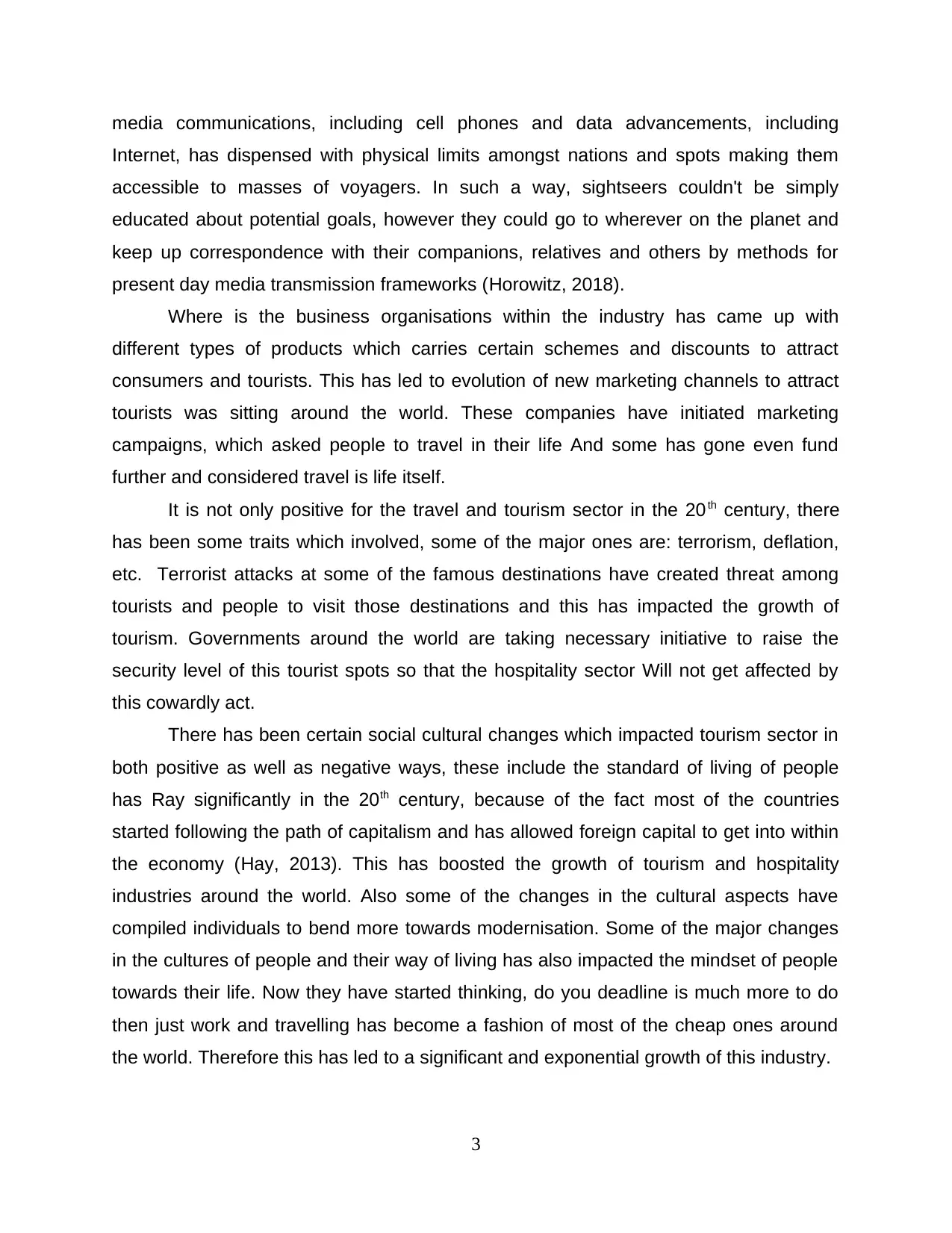
media communications, including cell phones and data advancements, including
Internet, has dispensed with physical limits amongst nations and spots making them
accessible to masses of voyagers. In such a way, sightseers couldn't be simply
educated about potential goals, however they could go to wherever on the planet and
keep up correspondence with their companions, relatives and others by methods for
present day media transmission frameworks (Horowitz, 2018).
Where is the business organisations within the industry has came up with
different types of products which carries certain schemes and discounts to attract
consumers and tourists. This has led to evolution of new marketing channels to attract
tourists was sitting around the world. These companies have initiated marketing
campaigns, which asked people to travel in their life And some has gone even fund
further and considered travel is life itself.
It is not only positive for the travel and tourism sector in the 20th century, there
has been some traits which involved, some of the major ones are: terrorism, deflation,
etc. Terrorist attacks at some of the famous destinations have created threat among
tourists and people to visit those destinations and this has impacted the growth of
tourism. Governments around the world are taking necessary initiative to raise the
security level of this tourist spots so that the hospitality sector Will not get affected by
this cowardly act.
There has been certain social cultural changes which impacted tourism sector in
both positive as well as negative ways, these include the standard of living of people
has Ray significantly in the 20th century, because of the fact most of the countries
started following the path of capitalism and has allowed foreign capital to get into within
the economy (Hay, 2013). This has boosted the growth of tourism and hospitality
industries around the world. Also some of the changes in the cultural aspects have
compiled individuals to bend more towards modernisation. Some of the major changes
in the cultures of people and their way of living has also impacted the mindset of people
towards their life. Now they have started thinking, do you deadline is much more to do
then just work and travelling has become a fashion of most of the cheap ones around
the world. Therefore this has led to a significant and exponential growth of this industry.
3
Internet, has dispensed with physical limits amongst nations and spots making them
accessible to masses of voyagers. In such a way, sightseers couldn't be simply
educated about potential goals, however they could go to wherever on the planet and
keep up correspondence with their companions, relatives and others by methods for
present day media transmission frameworks (Horowitz, 2018).
Where is the business organisations within the industry has came up with
different types of products which carries certain schemes and discounts to attract
consumers and tourists. This has led to evolution of new marketing channels to attract
tourists was sitting around the world. These companies have initiated marketing
campaigns, which asked people to travel in their life And some has gone even fund
further and considered travel is life itself.
It is not only positive for the travel and tourism sector in the 20th century, there
has been some traits which involved, some of the major ones are: terrorism, deflation,
etc. Terrorist attacks at some of the famous destinations have created threat among
tourists and people to visit those destinations and this has impacted the growth of
tourism. Governments around the world are taking necessary initiative to raise the
security level of this tourist spots so that the hospitality sector Will not get affected by
this cowardly act.
There has been certain social cultural changes which impacted tourism sector in
both positive as well as negative ways, these include the standard of living of people
has Ray significantly in the 20th century, because of the fact most of the countries
started following the path of capitalism and has allowed foreign capital to get into within
the economy (Hay, 2013). This has boosted the growth of tourism and hospitality
industries around the world. Also some of the changes in the cultural aspects have
compiled individuals to bend more towards modernisation. Some of the major changes
in the cultures of people and their way of living has also impacted the mindset of people
towards their life. Now they have started thinking, do you deadline is much more to do
then just work and travelling has become a fashion of most of the cheap ones around
the world. Therefore this has led to a significant and exponential growth of this industry.
3

Various concepts has been involved within this industry, some of these include
mass tourism and niche tourism. Mass tourism focuses more on tourist spot ready to
travel with a lot of peoples around them and therefore companies will book packages of
particular destinations for a lot of people in bulk and this will in turn raise their
productivity as well as profitability (LOIS-GONZÁLEZ, 2014). Mass tourism has turned
out to be more profitable for most of the companies as well as travel operators within
the industry, therefore it has become first preference for most of the tour operators, and
they will try to plan a tour which is based on masses and not on individual individual
families. Niche tourism on the other hand is concerned with individuals and their
demands and needs, two words plan for individuals on a personal basis. This kind of
concept is most suited for couples and people want to travel around the world alone and
not with people or masses.
Various marketing strategies are also followed by different organisations in order
to attract more and more customers as well as tourist. Hence, it is conceivable to
reason that mechanical and socio-social changes, including the improvement of
transportation framework, broadcast communications and data innovations, becoming
monetary and social participation between nations, the developing fame of western
culture on the planet, added to the steady difference in tourism industry. Tourism
industry stopped to be the business arranged on world class, rather it turned into the
rising business situated on mass-clients. In the meantime, the previously mentioned
changes impacted target goals since individuals could travel not just inside their nations
and districts where they lived, be that as it may, today, individuals can travel anyplace
they need since they have mechanical chances to movement worldwide and expenses
of making a trip diminished considerably contrasted with the mid twentieth century.
Thus, today, outlandish nations, including African, Eastern-Asian and other remote
nations ended up real goals for vacationers from the US, Europe, Canada, Japan and
other created nations, which contain the centre of visitors on the planet (Katic, Klarin
and McDonald eds., 2014). No doubt, tourism industry will continue developing later on
and vacationers from created nations will be more disposed to green tourism, while
visitors from creating nations might be more intrigued by instructive tourism, which
enables them to visit new nations and go to dialect schools, for example. At last,
4
mass tourism and niche tourism. Mass tourism focuses more on tourist spot ready to
travel with a lot of peoples around them and therefore companies will book packages of
particular destinations for a lot of people in bulk and this will in turn raise their
productivity as well as profitability (LOIS-GONZÁLEZ, 2014). Mass tourism has turned
out to be more profitable for most of the companies as well as travel operators within
the industry, therefore it has become first preference for most of the tour operators, and
they will try to plan a tour which is based on masses and not on individual individual
families. Niche tourism on the other hand is concerned with individuals and their
demands and needs, two words plan for individuals on a personal basis. This kind of
concept is most suited for couples and people want to travel around the world alone and
not with people or masses.
Various marketing strategies are also followed by different organisations in order
to attract more and more customers as well as tourist. Hence, it is conceivable to
reason that mechanical and socio-social changes, including the improvement of
transportation framework, broadcast communications and data innovations, becoming
monetary and social participation between nations, the developing fame of western
culture on the planet, added to the steady difference in tourism industry. Tourism
industry stopped to be the business arranged on world class, rather it turned into the
rising business situated on mass-clients. In the meantime, the previously mentioned
changes impacted target goals since individuals could travel not just inside their nations
and districts where they lived, be that as it may, today, individuals can travel anyplace
they need since they have mechanical chances to movement worldwide and expenses
of making a trip diminished considerably contrasted with the mid twentieth century.
Thus, today, outlandish nations, including African, Eastern-Asian and other remote
nations ended up real goals for vacationers from the US, Europe, Canada, Japan and
other created nations, which contain the centre of visitors on the planet (Katic, Klarin
and McDonald eds., 2014). No doubt, tourism industry will continue developing later on
and vacationers from created nations will be more disposed to green tourism, while
visitors from creating nations might be more intrigued by instructive tourism, which
enables them to visit new nations and go to dialect schools, for example. At last,
4
⊘ This is a preview!⊘
Do you want full access?
Subscribe today to unlock all pages.

Trusted by 1+ million students worldwide

considering the current monetary globalisation, it is conceivable to gauge the
improvement of business tourism later on.
CONCLUSION
This, it can be concluded the travel and tourism sector has seen various changes
in the 20th century. This changes has been in terms of technology and social cultural
changes. The major driver of the change has been the technological changes that has
taken place. It has led to invention of various ways to travel around the world like
development of Railroad, efficient infrastructure etc. governments around the world shall
start taking this sector seriously, if they want to achieve higher growth within their
economy and also to generate employment within the country.
5
improvement of business tourism later on.
CONCLUSION
This, it can be concluded the travel and tourism sector has seen various changes
in the 20th century. This changes has been in terms of technology and social cultural
changes. The major driver of the change has been the technological changes that has
taken place. It has led to invention of various ways to travel around the world like
development of Railroad, efficient infrastructure etc. governments around the world shall
start taking this sector seriously, if they want to achieve higher growth within their
economy and also to generate employment within the country.
5
Paraphrase This Document
Need a fresh take? Get an instant paraphrase of this document with our AI Paraphraser

REFERENCES
Books and Journals
Brooks, G., 2012. Heritage as a driver for development: Its contribution to sustainable
tourism in contemporary society.
Patarchanova, E., 2012. Socio-economic patterns and trends in rural development in
EU. Journal of Settlements and Spatial Planning. 3(2). p.151.
DAI, X.Y. and QUE, W.M., 2012. Mining Heritages in the Perspective of World Heritage
[J]. Scientia Geographica Sinica. 1. p.007.
Scott, D. and Gössling, S., 2015. What could the next 40 years hold for global tourism?.
Tourism Recreation Research. 40(3). pp.269-285.
Horowitz, I.L., 2018. One Hundred Years of Ambiguity: US-Cuba Relations in the 20th
Century. In Cuban Communism, 1959-2003 (pp. 25-33). Routledge.
Hay, B., 2013. From Leisure to Pleasure: Societal Trends and Their Impact on Possible
Future Scenarios for UK Rural Tourism in 2050.
LOIS-GONZÁLEZ, R.C., 2014. CHAPTER NINE NEW TRENDS IN URBAN AND
CULTURAL TOURISM: THE MODEL OF SANTIAGO DE COMPOSTELA. New
tourism in the 21st century: Culture, the city, nature and spirituality. p.209.
Katic, M., Klarin, T. and McDonald, M. eds., 2014. Pilgrimage and Sacred Places in
Southeast Europe: History, Religious Tourism and Contemporary Trends (Vol.
14). LIT Verlag Münster.
6
Books and Journals
Brooks, G., 2012. Heritage as a driver for development: Its contribution to sustainable
tourism in contemporary society.
Patarchanova, E., 2012. Socio-economic patterns and trends in rural development in
EU. Journal of Settlements and Spatial Planning. 3(2). p.151.
DAI, X.Y. and QUE, W.M., 2012. Mining Heritages in the Perspective of World Heritage
[J]. Scientia Geographica Sinica. 1. p.007.
Scott, D. and Gössling, S., 2015. What could the next 40 years hold for global tourism?.
Tourism Recreation Research. 40(3). pp.269-285.
Horowitz, I.L., 2018. One Hundred Years of Ambiguity: US-Cuba Relations in the 20th
Century. In Cuban Communism, 1959-2003 (pp. 25-33). Routledge.
Hay, B., 2013. From Leisure to Pleasure: Societal Trends and Their Impact on Possible
Future Scenarios for UK Rural Tourism in 2050.
LOIS-GONZÁLEZ, R.C., 2014. CHAPTER NINE NEW TRENDS IN URBAN AND
CULTURAL TOURISM: THE MODEL OF SANTIAGO DE COMPOSTELA. New
tourism in the 21st century: Culture, the city, nature and spirituality. p.209.
Katic, M., Klarin, T. and McDonald, M. eds., 2014. Pilgrimage and Sacred Places in
Southeast Europe: History, Religious Tourism and Contemporary Trends (Vol.
14). LIT Verlag Münster.
6
1 out of 8
Related Documents
Your All-in-One AI-Powered Toolkit for Academic Success.
+13062052269
info@desklib.com
Available 24*7 on WhatsApp / Email
![[object Object]](/_next/static/media/star-bottom.7253800d.svg)
Unlock your academic potential
Copyright © 2020–2026 A2Z Services. All Rights Reserved. Developed and managed by ZUCOL.





